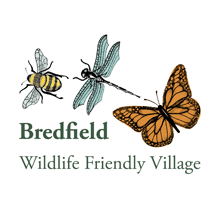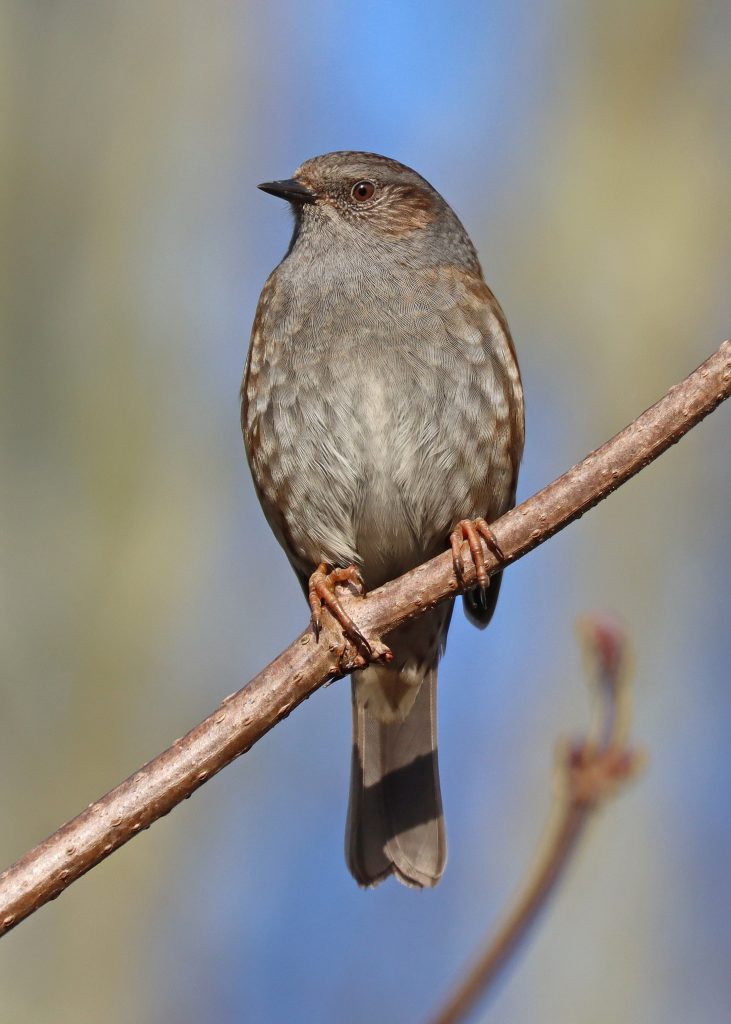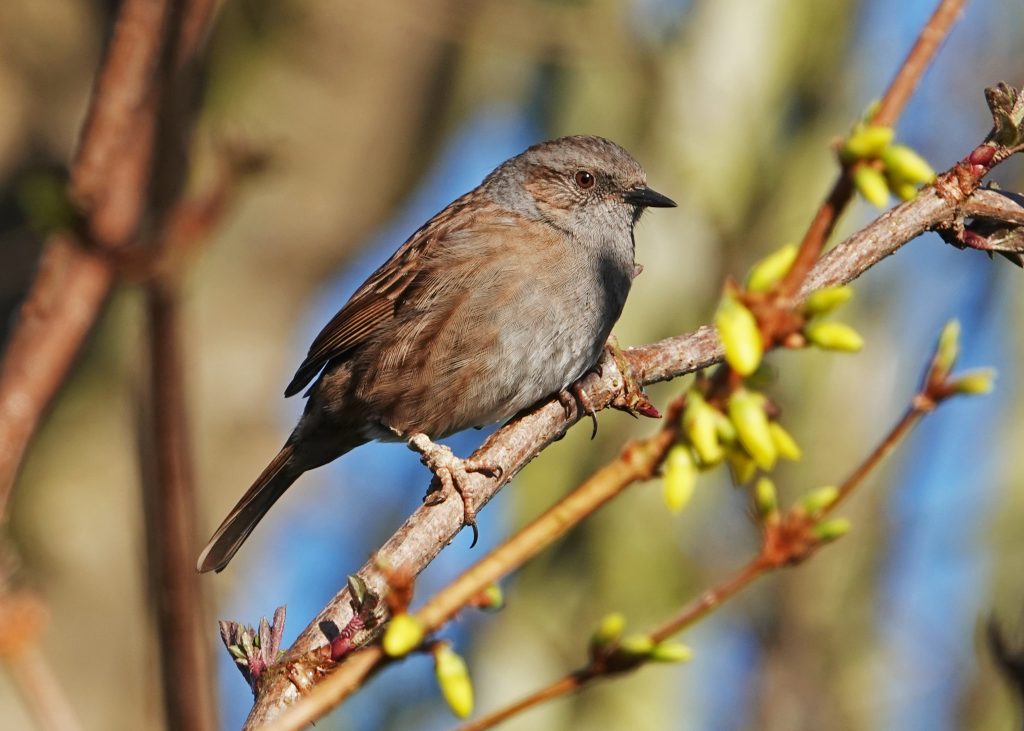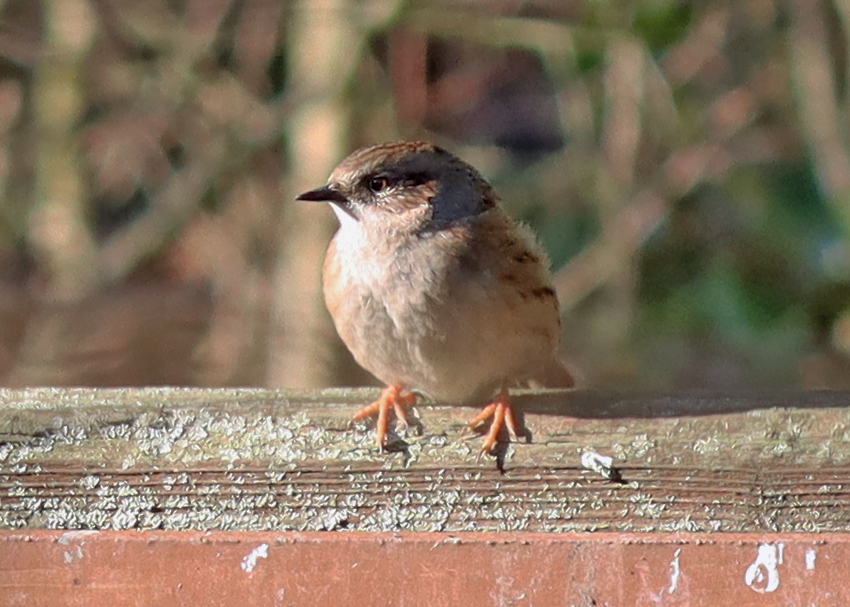Not the most exciting name for a bird is it: ‘Dunnock’? Today, birds like this are called LBJs; ‘little brown jobs’. The Dunnock been considered as such for many centuries, for its name derives from the Od English for ‘little brown’. The Dunnock’s scientific name is Prunella modularis. Again, ‘Prunella’ refers to its brown plumage. Like many aspects of nature, what appears dull at a cursory glance, may be much more interesting in colours and patterns upon closer inspection. (The Dunnock is also much more interesting in its behaviour, but more on that later.) Viewed closer, the Dunnock has a subtly attractive plumage of streaks and differing shades of russet and grey. The ‘modularis’ part of the bird’s name comes from the Latin word ‘modulari’, which means to sing or warble, and this part of the name recognises that, though seemingly dull in plumage, it has a very bright song. The Dunnock is sometimes referred to as ‘Hedge Sparrow’, but this is most confusing as it isn’t a Sparrow at all. It belongs to the Accentor bird family, so ‘Hedge Accentor’ would be a more accurate name.
The Dunnock is a common bird and it will visit, if not nests in, most Bredfield gardens. They are relatively shy birds and you’ll see them hopping about amongst garden plants and bushes, feeding on seeds, insects, spiders and other small invertebrates. They are most unlikely to perch on your bird feeder, but you may see them foraging for fallen seeds underneath the feeder. Potentially, this may cause a problem for the bird. The area underneath a bird feeder is frequented by several species of birds (which normally may not come together) and the risk of picking up a disease (such as ‘scaly leg’ – see bird pictured below) is increased. This is why it is important to move your feeder regularly. If you want to help your local Dunnock in another way, you could spread a few seeds in a separate area of low cover.
Dunnocks nest between April and July, laying up to five eggs. They won’t use the sort of next boxes that Blue Tits and Great Tits frequent, but they may use well-hidden, open-fronted boxes. Usually, Dunnocks build well-camouflaged nests in thick bushes, hedges or amongst Ivy where it clads walls or fences. In the countryside, Dunnocks’ nests are often targeted by Cuckoos. We might think that the speckled egg of the Cuckoo would show obviously amongst the bright-blue eggs of the Dunnock, but the hosts don’t eject the imposter’s egg. Cuckoos have an insignificant impact on Dunnock populations: not only because Cuckoos are now a species declining in number; but because Dunnocks often rear two-or-three large broods every year.
Dunnocks might appear dull and insignificant, but appearances can be deceptive. Beneath your garden flowers and bushes, Dunnocks are engaging in a bizarre secret life of infidelity, partner-sharing and uncertain parentage. As Keith Broomfield has said: “the Dunnock has a most racy sex life which if replicated amongst the good folk of a country parish would be deemed as quite scandalous.*” Let’s now turn to look at this tale of sexual intrigue.
The territories of male Dunnocks are larger than those of the females, so it’s not unusual for a single male to have access to more than one female, giving rise to polygyny. Sometimes the situation is more complex, where two males share a territory. One of these males will attain the position of the ‘alpha bird’. Despite the alpha bird spending a lot of time guarding ‘his’ female (following her around for up to 40 minutes in every hour), inevitably there will be chances for the ‘beta bird’ to sneak-in and mate with the alpha bird’s partner. This is polyandry, where two males are paired with the same female. Why doesn’t the female reject the beta male’s advances? Well, the hen Dunnock is engaging in underhand trickery. After mating with one male, a subsequent male will peck at her rear in an attempt to get her to eject the sperm of the previous suitor, and then he will mate with her. Now, two males think that they are the father, and the female gets two helpers to feed the nestlings. What deception! But it raises the chance of a successful brood considerably.
Confused? Well, it can sometimes become more complex with two or more males partnering two or more females at the same time. Gosh! You may be pleased to know that some Dunnocks are rather more conventional and engage in good old-fashioned monogamy.
The Dunnocks in your garden are likely to be local birds, born within a few kilometres. However. Dunnocks from northern Europe undertake long annual migrations and one or more of these birds may end up in your garden in the winter. At that time of the year your resident bird will be more tolerant of visitors to his territory.
*Broomfield, K. (2017) ‘The Racy Sex Life of the Dunnock’, Wildlife, BTO.
All photographs taken in Bredfield by the author.




